Interstate 794 Named Freeway Without A Future
Congress for the New Urbanism report will include downtown Milwaukee highway.
Livable cities organization the Congress for the New Urbanism (CNU) will name Interstate 794 in downtown Milwaukee as one of its 10 “Freeways Without Futures” in an upcoming report.
The nomination comes as a result of a campaign by the Rethink 794 coalition to replace the east-west portion of the elevated freeway between Downtown and the Historic Third Ward with a boulevard. The organization is asking the Wisconsin Department of Transportation (WisDOT) to formally study a boulevard replacement between N. Lincoln Memorial Dr. and N. 6th St.
CNU will release its full report in April. Since its initial report in 2008, it has released six lists of freeways that it believes should be replaced with boulevards or otherwise eliminated. It also maintains a “Highways To Boulevards” project that features Milwaukee’s 2004 removal of the Park East Freeway as of its 15 examples.
Many of the freeways in CNU’s initial list have been removed or reconfigured, while others have been rebuilt largely as is. Only one, the Claiborne Expressway (I-10) in New Orleans, continues to roll over and appeared on the latest list from 2021.
“This year’s report is the first to coincide with acknowledgment from the federal government of the inequitable and harmful impacts of urban highway construction,” said CNU in announcing its 2023 list. “A number of campaigns featured in the report are applicants for federal Reconnecting Communities grant financing.”
The 175 conversion project did not make CNU’s list. The Rethink 794 coalition has been supportive of the project, but has pushed what it believes is the even greater development potential of the downtown project.
Based on conceptual estimates, the group believes the underlying 32 acres could see $1.5 billion in new development and generate $15 million annually in new property tax revenue. WisDOT is proposing to rebuild a portion of the highway from 1974 at a cost of $300 million.
“From a math standpoint, it’s a no-brainer,” said Ben Crowther, advocacy manager for national nonprofit America Walks, in October.
Other cities with highways on the list include Albany, Austin, Baltimore, Oakland, Seattle, Tulsa and Youngstown, OH.
“The ten campaigns and the broader Highways to Boulevards movement offer a path for communities to repair, rebuild, and reknit their urban fabric by replacing oppressive, aging infrastructure with assets like city streets, housing, and green space,” wrote CNU in announcing the list and impending report. “These assets become places for people to live, work, and play, with local businesses and sites for public interaction, and improved connections with public transit systems. As end-stage urban freeways and their adjacent corridors offer opportunities for transformation, elected officials and citizens alike can be advocates for change that support socially and economically valuable places.”
The full report is expected to be released in April.
Former Milwaukee Mayor John Norquist led CNU from 2004 to 2014. He was the driving force behind a coalition of partners that removed the Park East Freeway.
Rethink 794 Conceptual Renderings
If you think stories like this are important, become a member of Urban Milwaukee and help support real, independent journalism. Plus you get some cool added benefits.
More about the Interstate 794 Rebuild
- Real Estate Group Casts Doubt on I-794 Removal Plan - Jeramey Jannene - Nov 11th, 2025
- See How State Thinks Traffic Would Change With I-794 Removal - Jeramey Jannene - Nov 5th, 2025
- Public Meetings Upcoming On Possible I-794 Removal, Replacement - Jeramey Jannene - Oct 17th, 2025
- WisDOT Unveils Four Options To Rebuild I-794 - Jeramey Jannene - May 30th, 2025
- Open House Scheduled On Revised Plans To Replace I-794 - Jeramey Jannene - May 9th, 2025
- UWM Students Design A Future Without I-794 - Jeramey Jannene - May 2nd, 2025
- See New Options To Slim I-794 in Downtown or Make It A Boulevard - Jeramey Jannene - Apr 2nd, 2025
- Freeway-to-Boulevard Option Still On Table for 794 Rebuild - Jeramey Jannene - Jan 30th, 2025
- Converting 794 To Boulevard Could Yield 3,000 Housing Units, $1.1 Billion in Development - Jeramey Jannene - Nov 21st, 2024
- See What Boulevard Replacing I-794 in Downtown Would Look Like - Jeramey Jannene - Jul 30th, 2024
Read more about Interstate 794 Rebuild here
Transportation
-
Congestion Pricing Cuts Air Pollution in New York City
 Dec 14th, 2025 by Jeff Wood
Dec 14th, 2025 by Jeff Wood
-
FTA Tells Milwaukee to Crack Down on Fare Evasion — Even Where Fares Don’t Exist
 Dec 12th, 2025 by Graham Kilmer
Dec 12th, 2025 by Graham Kilmer
-
Will GOGO’s Bus Service Ever Get Going?
 Dec 9th, 2025 by Jeramey Jannene
Dec 9th, 2025 by Jeramey Jannene


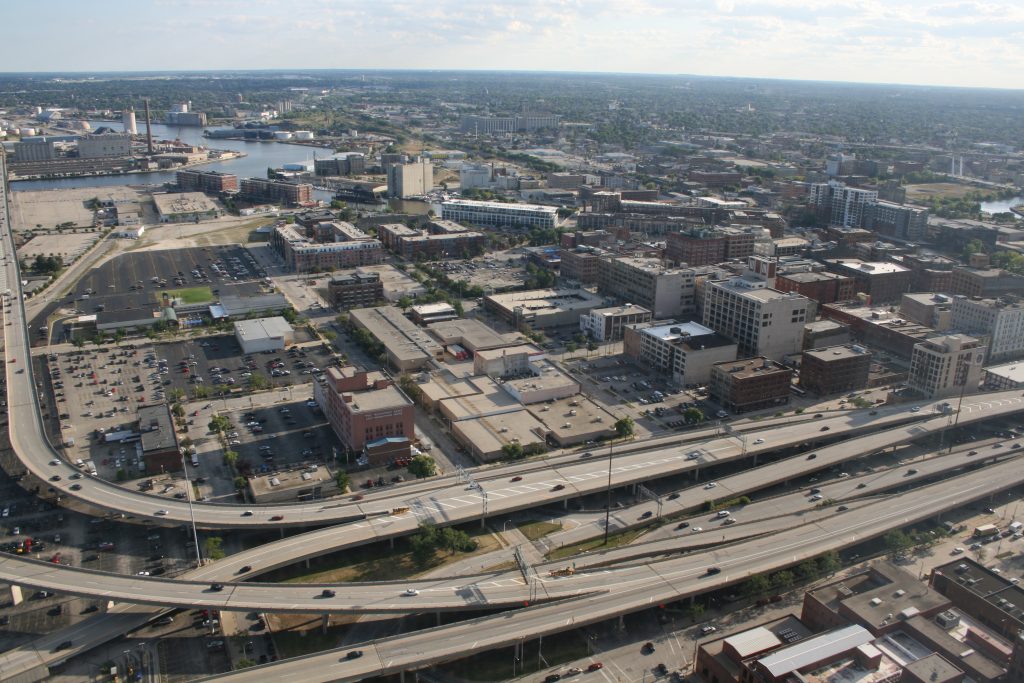
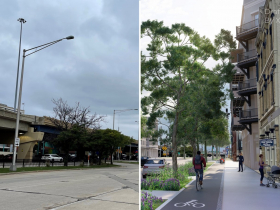
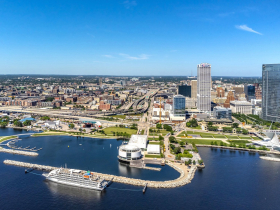
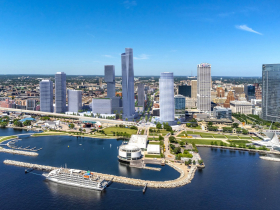
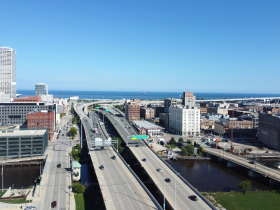
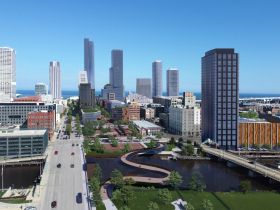
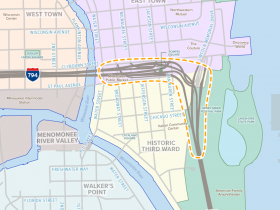




















What is the best use of the land underneath I794? It would include a diverse mix of uses including business, entertainment, and housing in the full spectrum of diversity. However, this mix is not necessarily a “no brainer.” On the contrary, it would be important to use “brainer” (intelligent) thinking to avoid creating a low-density, suburban-style landscape that doesn’t allow a truly urban form to flourish. Some of the renderings–the windy footpath over the river, for example, seem a foolish use of space. The emphasis on low-slung buildings that seem more comfortable in Brookfield than downtown Milwaukee are disconcerting. The state’s largest city should use this land to foster, in a true, urban sense, the walkable urbanism and walking and transit fabrics that have been lost in the past century. Housing built should be full-spectrum in terms of type and price, allowing affordable micro apartments to luxury condos–and everything in between. Don’t be afraid of taller buildings–the value of the land and its placement are appropriate for them. Allow many different builders and enterprises maximize the number and type of mixed uses that would be built.
I agree completely that we would want diverse uses within the confines of the street grid and with no fear of tall buildings. I think whatever planning that comes into play *when* I-794 comes down would need to take into account a couple of things: (1) It has been two decades since the Park East Freeway has come down and there are still apparently five blocks that have not been developed. Milwaukee does not have a good track record of clearing land to attract near-term development. (4th and Wisconsin, anyone? Plankinton and Kilbourn?) So, really thinking through best uses coupled with a dose of reality and “what the market will bear” sounds advisable. (2) Physical location retail is in freefall and the future need for physical office space is a huge question mark. (And, at least for now, it appears that current and pipelined luxury rental projects downtown have reached their saturation point.) So, I would suggest a major focus on residential at other income levels and a real “catalytic project or two,” even if that does mean a park or public square. Parks are in relative short supply downtown (aside from the Lakefront on the eastern edge and the desolate MacArthur Square). People like ’em!
No input from anyone who uses 794 on a daily basis to get to and from work. Plenty of ideas from those who will not be inconvenienced by this. Oh, I guess they know what’s good for me. I should sit in traffic admiring the new development.
Developers, Investers & Realtors are focused on their profits. Enough already!
I’m strongly opposed to removing 794. I use it daily. Residents & commuters needs must be of the utmost importance.
Survey to every household & business in Southeast corridor. Including southern county line & 4 miles west.
Additional issues:
I-794 traffic would overwhelm traffic on I-94 South.
Access to Summerfest, Ethnic Festivals & the Theatre District.
Enviromental impact of demolition.
The pitch to build expressways is that they will enable a large volume of traffic to quickly and conveniently get to and from places. This will result in greater economic activity and wealth creation. 60 years ago, public officials accepted that argument and spent enormous amounts of money acquiring and clearing land and building them. Now advocacy groups are saying that an expressway does not benefit the economy? What they say benefits the economy is spending enormous amounts of money removing the expressway in order to clear the land they were built on. Next sell the land for hotels, coffee shops, apartments, office buildings, or any other structure a developer is willing to build. Finally, build a stroad to serve the dual function of providing access to the new land uses and to handle the traffic the expressway once served. Naturally, failing at both.
Someone has it wrong. Either the high-speed connectivity over a broad area provided by an expressway provides greater economic value or real estate development on the same land provides greater economic value.
The advocates of freeway removal are like a businessman that touts only the credit column of his balance sheet and declares how much money their project is going to be worth. If the public looks at the debit column, they might see a very different picture.
I-794 not only provides fast and efficient access to east downtown for anyone travelling on I-94/43, but also connects with Lincoln Memorial Drive and Lake Parkway. Removing it will affect the access of not only downtown commuters and patrons of Summerfest and the museums, but to businesses ranging north and south for several miles. Yes, some will still endure the delay of stop-and-go traffic, as they slog down the new stroad, to travel a distance that used to take them a minute. Others will not. Others will change their buying, and even, living patterns as they did when the expressways were constructed.
What is the cost to Summerfest alone, if only a small percentage of potential patrons decide that access is now too much of a hassle?
Any promises of economic benefit from I-794 removal should be carefully scrutinized. The negative economic cost should be weighed against any verified benefit that advocates are claiming for their plan.